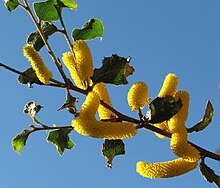| Sandpaper wattle | |
|---|---|

| |
| Conservation status | |
 Vulnerable (EPBC Act) | |
| Scientific classification | |
| Kingdom: | Plantae |
| Clade: | Tracheophytes |
| Clade: | Angiosperms |
| Clade: | Eudicots |
| Clade: | Rosids |
| Order: | Fabales |
| Family: | Fabaceae |
| Subfamily: | Caesalpinioideae |
| Clade: | Mimosoid clade |
| Genus: | Acacia |
| Species: | A. denticulosa |
| Binomial name | |
| Acacia denticulosa F.Muell. | |

| |
| Occurrence data from AVH | |
| Synonyms | |
|
Racosperma denticulosum (F.Muell.) Pedley | |
Acacia denticulosa, commonly known as sandpaper wattle, is a species of Acacia native to the south-west of Western Australia. A spindly shrub 1–4 m high, it flowers from September to October, producing dense, curved, yellow flower spikes.
Taxonomy
Acacia denticulosa was first formally described in 1876 by Victorian Government Botanist Ferdinand von Mueller based on plant material collected from the vicinity of Mount Churchman by Jess Young. The population at this location is now extinct following extended drought. The species name is from the Latin dens "tooth", and refers to the small teeth along the phyllode margins. Queensland botanist Les Pedley reclassified the species as Racosperma denticulosum in 2003, in his proposal to reclassify almost all Australian members of the genus into the new genus Racosperma, however this name is treated as a synonym of its original name.
Description
Sandpaper wattle grows as a spindly shrub with an open habit from 1 to 4 m (3.3 to 13.1 ft) high and 3 m (9.8 ft) wide. Young stems are rough and warty, as are the dark green phyllodes. Like other wattles, its leaf-like structures are actually enlarged and flattened petioles known as phyllodes. These are irregularly oval in shape, 5–9 cm (2.0–3.5 in) long and 3.5–7.5 cm (1.4–3.0 in) wide and prominently veined. Flowering occurs over September and October, the prominent cylindrical golden flower spikes are 3–8 cm long and arise from the leaf axis. These are followed by straight or just curved seedpods that are up to 7.5 cm (3.0 in) long and 0.3–0.45 cm (0.12–0.18 in) wide. They have prominent swellings along them that mark where the seeds are. The seeds themselves are a shiny brownish black and measure 0.35–0.4 cm (0.14–0.16 in) in length.
Distribution and habitat
Sandpaper wattle is found in eight scattered populations over a range of 180 km (110 mi) in the Merredin district in the Western Australian Wheatbelt northeast of Perth, over an area roughly bounded by Nungarin in the south, Wongan Hills in the west and east of Mount Churchman in the east. It generally grows on or near granite outcrops, and occasionally on sandplains, or a range of soils such as silt, clay, loam or sand.
It is listed as vulnerable under both Western Australian and Federal legislation. Key threats include continuing land clearance in its vicinity, altered hydrology and extended drought. Local invasive weeds that may directly impact on it include bridal creeper (Asparagus asparagoides), saffron thistle (Carthamus lanatus) and cape tulip (Moraea flaccida).
Cultivation
Sandpaper wattle has horticultural features including its unusual leaves and bright flowers. It is also bird-attracting. All wattles are legumes and hence fix nitrogen in the soil. Readily grown from seed, it is fast growing and can flower within the first year. Flowering can last until early summer in cultivation. It requires a sunny aspect and good drainage, though might not adapt well to areas with humid summers.
See also
References
- ^ Acacia denticulosa — Sandpaper Wattle, Species Profile and Threats Database, Department of the Environment and Heritage, Australia.
- ^ "Acacia denticulosa". FloraBase. Western Australian Government Department of Biodiversity, Conservation and Attractions.
- ^ "Acacia denticulosa". Australian Plant Name Index (APNI), IBIS database. Centre for Plant Biodiversity Research, Australian Government, Canberra. Retrieved 21 March 2011.
- Elliot, Rodger W.; Jones, David L.; Blake, Trevor (1985). Encyclopaedia of Australian Plants Suitable for Cultivation: Vol. 2. Port Melbourne: Lothian Press. p. 41. ISBN 978-0-85091-143-5.
- Pedley, Les (2003). "A synopsis of Racosperma C.Mart. (Leguminosae: Mimosoideae)". Austrobaileya. 6 (3): 445–496 . doi:10.5962/p.299681.
- ^ Mannel, Sarah (2012). "Acacia denticulosa". Growing Australian Plants. Australian National Herbarium. Retrieved 9 May 2014.
- ^ CSIRO (29 May 2013). "Acacia denticulosa F.Muell., Fragm. 10: 32 (1876)". World Wide Wattle. Australian Biological Resources Study, Canberra, and the Department of Conservation and Land Management, Perth. Retrieved 9 May 2014.
- Department of the Environment (26 March 2008). "Approved Conservation Advice for Acacia denticulosa (Sandpaper Wattle)" (PDF). Canberra ACT: Commonwealth of Australia. Retrieved 9 May 2014.